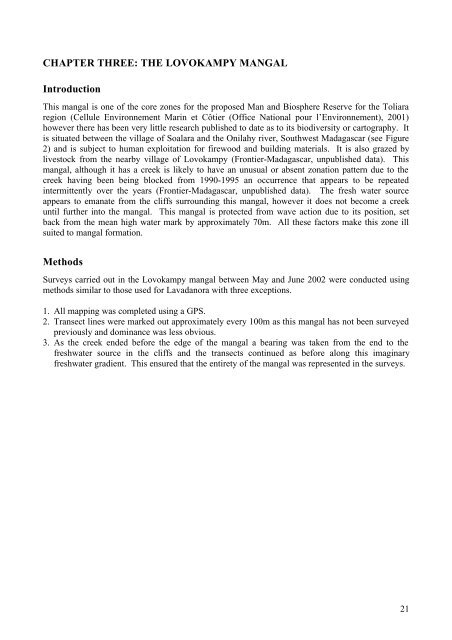Mangrove biodiversity survey south of the Onilahy River - Frontier ...
Mangrove biodiversity survey south of the Onilahy River - Frontier ...
Mangrove biodiversity survey south of the Onilahy River - Frontier ...
You also want an ePaper? Increase the reach of your titles
YUMPU automatically turns print PDFs into web optimized ePapers that Google loves.
CHAPTER THREE: THE LOVOKAMPY MANGAL<br />
Introduction<br />
This mangal is one <strong>of</strong> <strong>the</strong> core zones for <strong>the</strong> proposed Man and Biosphere Reserve for <strong>the</strong> Toliara<br />
region (Cellule Environnement Marin et Côtier (Office National pour l’Environnement), 2001)<br />
however <strong>the</strong>re has been very little research published to date as to its <strong>biodiversity</strong> or cartography. It<br />
is situated between <strong>the</strong> village <strong>of</strong> Soalara and <strong>the</strong> <strong>Onilahy</strong> river, Southwest Madagascar (see Figure<br />
2) and is subject to human exploitation for firewood and building materials. It is also grazed by<br />
livestock from <strong>the</strong> nearby village <strong>of</strong> Lovokampy (<strong>Frontier</strong>-Madagascar, unpublished data). This<br />
mangal, although it has a creek is likely to have an unusual or absent zonation pattern due to <strong>the</strong><br />
creek having been being blocked from 1990-1995 an occurrence that appears to be repeated<br />
intermittently over <strong>the</strong> years (<strong>Frontier</strong>-Madagascar, unpublished data). The fresh water source<br />
appears to emanate from <strong>the</strong> cliffs surrounding this mangal, however it does not become a creek<br />
until fur<strong>the</strong>r into <strong>the</strong> mangal. This mangal is protected from wave action due to its position, set<br />
back from <strong>the</strong> mean high water mark by approximately 70m. All <strong>the</strong>se factors make this zone ill<br />
suited to mangal formation.<br />
Methods<br />
Surveys carried out in <strong>the</strong> Lovokampy mangal between May and June 2002 were conducted using<br />
methods similar to those used for Lavadanora with three exceptions.<br />
1. All mapping was completed using a GPS.<br />
2. Transect lines were marked out approximately every 100m as this mangal has not been <strong>survey</strong>ed<br />
previously and dominance was less obvious.<br />
3. As <strong>the</strong> creek ended before <strong>the</strong> edge <strong>of</strong> <strong>the</strong> mangal a bearing was taken from <strong>the</strong> end to <strong>the</strong><br />
freshwater source in <strong>the</strong> cliffs and <strong>the</strong> transects continued as before along this imaginary<br />
freshwater gradient. This ensured that <strong>the</strong> entirety <strong>of</strong> <strong>the</strong> mangal was represented in <strong>the</strong> <strong>survey</strong>s.<br />
21
















